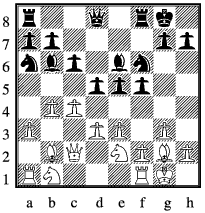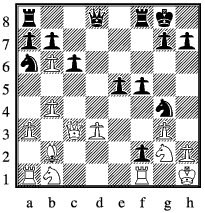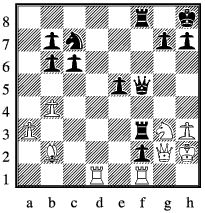Tues 3rd: HH in the spotlight
HH, occasional contributor to this blog, gets an article to himself as he was RR's latest opponent when Newcastle visited Fenton last night. Typical classical grab the centre play by HH drew a fairly limp response from RR as black, so that HH has a substantial advantage as we join the game after whites 19th move, on which he offered a draw.
 My reaction of course was to accept. Except this is a match, and one we really need to win if we want to finish above Fenton. Top board Alan is a pawn down with queen, rook and bishop each. It looks headed for a same coloured bishop ending, with Alan's the better, but with so many pawns on - eight including a doubled d-pawn v seven - I'm not sure that this is heading anywhere but a draw. Meanwhile Tim has already drawn on three, whilst our bottom two boards have mustered just a single win each all season for the team. Neither appears to be ahead. So if there is to be a win it could well need to be me.
My reaction of course was to accept. Except this is a match, and one we really need to win if we want to finish above Fenton. Top board Alan is a pawn down with queen, rook and bishop each. It looks headed for a same coloured bishop ending, with Alan's the better, but with so many pawns on - eight including a doubled d-pawn v seven - I'm not sure that this is heading anywhere but a draw. Meanwhile Tim has already drawn on three, whilst our bottom two boards have mustered just a single win each all season for the team. Neither appears to be ahead. So if there is to be a win it could well need to be me.
19 ... dxe5, 20 fxe5 Bc5, 21 Qd2 Bxe3, 22 Qxe3 f4, 23 Qe4 Ng3
24 Nxg3 fxg3+, 25 Kxg3 all of which we had both seen, and it remained to see whether HH would allow me to survive against his monstrous pawn centre.
In order to stop him gaining this I would have liked to play
22 ... Qxd5, 23 gxh5 but although his pawns are all over the place his material advantage is just too great, particularly with his h-pawn now holding back my g-pawn.
A more effective disruptive variation that I missed:

21 ... fxg4, 22 hxg4 Nef6, 23 exf6 Nxf6, 24 Bxc5 Rxc5 (see diagram right) when even Nc3 does not save white's d-pawn - black has Qc7+ to escape any pin subsequent to Nxd5. Thus black emerges with two pawns for the knight and some chances of play against the relatively exposed white king.
Back to the game as played:
25 ... Qe7, 26 Rae1 Qb4. Abandoning defence, but there is no way I can expect to mount a successful blockade.
27 Ng5 g6, 28 Rxf8+ Qxf8, 29 Re3 Ng7, 30 Rf3 Qc5, 31 Kg2 Qb4
32 Qd4 Qe1 if he plays Qf4 I now have to go back to b4.
33 d6
Mustn't allow Qd5+ so 33 ... Qe2+, 34 Rf2 Qd3, 35 Rd2 Qxd4
36 Rxd4 h6, 37 Ne4 Ne6, 38 Nf6+ Kf7
We have now reached diagram left.
 HH is still reluctant to push on with d7, so retreated with 39 Rd1 giving me the opportunity to cut his rook from the pawns with
HH is still reluctant to push on with d7, so retreated with 39 Rd1 giving me the opportunity to cut his rook from the pawns with
39 ... Nf4+, 40 Kg3 Nd3
Belatedly HH plays
41 d7, but it is no longer effective.
41 ... Rd8, 42 b3 Nxe5, 43 Ne4 I had expected Rf1 to maintain support for the d-pawn
43 ... cxb3, 44 axb3 Rxd7, 45 Rb1 Rd3+, 46 Kg2 Ke6 (a5 more accurate)
47 Rb2 a5, 48 g5 hxg5, 49 Nxg5+ Kf5, 50 Nh7 Nf3, 51 Nf8 Rd2+ 0-1
Our bottom boards drew, and Alan found (or was allowed to generate) a win, so I could have accepted the draw on move 19 after all!
comment on this article
Wed 4th: Don't play the best moves.
Some players try to treat the game as one long opening, and once they are out of their book immediately look to sue for peace unless their opponent has committed an atrocity. The rest of us are familiar with the idea that putting our games on Fritz will result in a rainbow of yellow and red lights (and hopefully a few greens too) as the program makes its assessment of the moves. This can be useful in helping us to uncover ideas that we might miss when analysing alone. But should we always look to play green light moves?
The green light shows that the move made is (close to) the best possible in terms of the program's assessment of the resulting position. However if the assessment is that you are the equivalent of two pawns down, playing moves that hold this deficit (if the assessment is accurate) is still leaving you in a lost position. This gives rise to two schools of thought:
School I says that you should always look to play the best objective move. When behind sit tight and wait for your opponent to go wrong.
School II looks to play the best practical move. When behind this may be an objectively inferior move that gives the opponent a greater chance of going wrong. It need not be an outright trap, but by giving the opponent something to worry about can encourage him to make unnecessary moves. These may give you time to coordinate your pieces or achieve some objective. Remember it can be very tempting when ahead to try to stop any play by your opponent, even though by so doing you can end up losing the initiative. When behind, play on this.
In effect School I says that opponents are more likely to make small mistakes than big ones, so your best chance of getting back into the game is to keep the deficit small. School II says that opponents are more likely to make mistakes of any size if you give them options. So give them options even if this increases your deficit.
Naturally RR tries to belong to both schools at once. Ideally he would wish to put up the barricades in positions in which an attacker can easily lose his way, but look for any move with a threat in those positions in which sitting tight is an open invitation for his opponent to take as long as he likes to beat him. Can RR accurately identify which positions are which? No prizes for guessing the short answer to that one!
And when ahead? Clearly missing forced mates is always bad, as it means there are still moves in the game for your opponent to pull a rabbit from the hat. However I'm not convinced that all yellow or red moves need to be expunged from one's play. Making an inferior move that simplifies a position whilst leaving you with an healthy edge can reduce the chance of further error in the game and so may still be a sensible practical choice.
Footnote
When this article originally appeared it finished with a poll about Mark Whitby's image of Suicidal Pawn. Given a choice between
a picture of abject suicidal misery,
sign him up for the SAS,
makes ME want to commit suicide,
if that's suicidal I'm a mermaid
the last drew 100% support.
comment on this article
Thu 5th: Was I right?
Clubmate Sam asked me the "Was I right?" question after his match last night. He took a draw with his opponent very short of time and both sides owning queen, rook, same coloured bishop and (I believe) 4 pawns each in two islands for his opponent, three for himself. Should he have played on knowing that inevitably his opponent would lose on time?
This I think is entirely a matter for the individual. Materially level, yes, and depending on the exact locations of the pieces it is probably close to positionally level too. Sam should not be criticised by either himself or teammates for taking the draw as he clearly believed that was the right result for the game.
Equally when playing in our league players undertake to complete their game in 85 minutes each. If they want a win they have to prove it - secure a mate - in the time available unless their opponent elects to concede the win by resigning. Similarly to get a draw you have to prove it - reach a dead position or demonstrate by the moves you make that you know how to draw the position - unless your opponent agrees the draw.
With an open position and the material available Sam's game was clearly still live, and so he is entitled to play on looking for a win even though he knows his search will be interrupted by his opponent's flag fall. He does not need to be able to demonstrate a complete winning plan. What he is not entitled to do is make random moves waiting for the flag fall - in this case his opponent would be entitled to claim a draw on the basis that Sam was not trying to win by normal means. This claim would need to be made before the flag fell.
There is no moral high ground with this situation. Whether his opponent fell behind on the clock due to an unsuccessful search for a superior line or through the necessity of taking care to live with Sam's quality of play, the clock is part of the game. Mistakes/blunders made under time pressure can and do arise. You are entitled to benefit from these if your opponent falls into time trouble, or to win on time even though you are not ahead at that point.
This leads naturally to the question "Are you entitled to win on time in an inferior position?" The answer is "Yes, but". The 'but' being that if you have a substantial deficit then a draw claim by your opponent on the basis that you are not trying to win by normal means would succeed. Suppose for example that you were a rook down with no compensation. Could you really claim that you were playing on looking for a win over the board as opposed to on the clock? Deciding on how big a deficit represents a substantial deficit is of course where arbiters earn their corn. Sensible players with the upper hand but shortage of time avoid the problem by offering a draw sufficiently far from their flag fall that their opponent has to accept the offer, being unsure as to whether the win can be secured in the time available. The 'have my cake and eat it' approach of pressing for a win until the last few seconds and then claiming the draw may not impress the arbiter.
comment on this article

 My reaction of course was to accept. Except this is a match, and one we really need to win if we want to finish above Fenton. Top board Alan is a pawn down with queen, rook and bishop each. It looks headed for a same coloured bishop ending, with Alan's the better, but with so many pawns on - eight including a doubled d-pawn v seven - I'm not sure that this is heading anywhere but a draw. Meanwhile Tim has already drawn on three, whilst our bottom two boards have mustered just a single win each all season for the team. Neither appears to be ahead. So if there is to be a win it could well need to be me.
My reaction of course was to accept. Except this is a match, and one we really need to win if we want to finish above Fenton. Top board Alan is a pawn down with queen, rook and bishop each. It looks headed for a same coloured bishop ending, with Alan's the better, but with so many pawns on - eight including a doubled d-pawn v seven - I'm not sure that this is heading anywhere but a draw. Meanwhile Tim has already drawn on three, whilst our bottom two boards have mustered just a single win each all season for the team. Neither appears to be ahead. So if there is to be a win it could well need to be me. HH is still reluctant to push on with d7, so retreated with 39 Rd1 giving me the opportunity to cut his rook from the pawns with
HH is still reluctant to push on with d7, so retreated with 39 Rd1 giving me the opportunity to cut his rook from the pawns with  RR is black, and we join the game after 11 Bb2, with RR's central space advantage and latent pressure on f2 providing him with rough compensation for his awkwardly placed queenside pieces - he may find his knight revisiting b8. RR eschews sensible moves such as dxc4 and Bc7 in favour of the temptation to tempt white to go down a line that's tempting me!.
RR is black, and we join the game after 11 Bb2, with RR's central space advantage and latent pressure on f2 providing him with rough compensation for his awkwardly placed queenside pieces - he may find his knight revisiting b8. RR eschews sensible moves such as dxc4 and Bc7 in favour of the temptation to tempt white to go down a line that's tempting me!.
 17 ... Qg5 Rf6 is better as with the game move white now can complete development with Nd2. Instead he seeks to exchange queens
17 ... Qg5 Rf6 is better as with the game move white now can complete development with Nd2. Instead he seeks to exchange queens 30 ... Qg6 Qf4 retaining protection of the f-pawn and pinning the knight must be better. Here white can play Rd2 and the f-pawn dies together with black's attack. Instead he grabs the loose e-pawn.
30 ... Qg6 Qf4 retaining protection of the f-pawn and pinning the knight must be better. Here white can play Rd2 and the f-pawn dies together with black's attack. Instead he grabs the loose e-pawn.